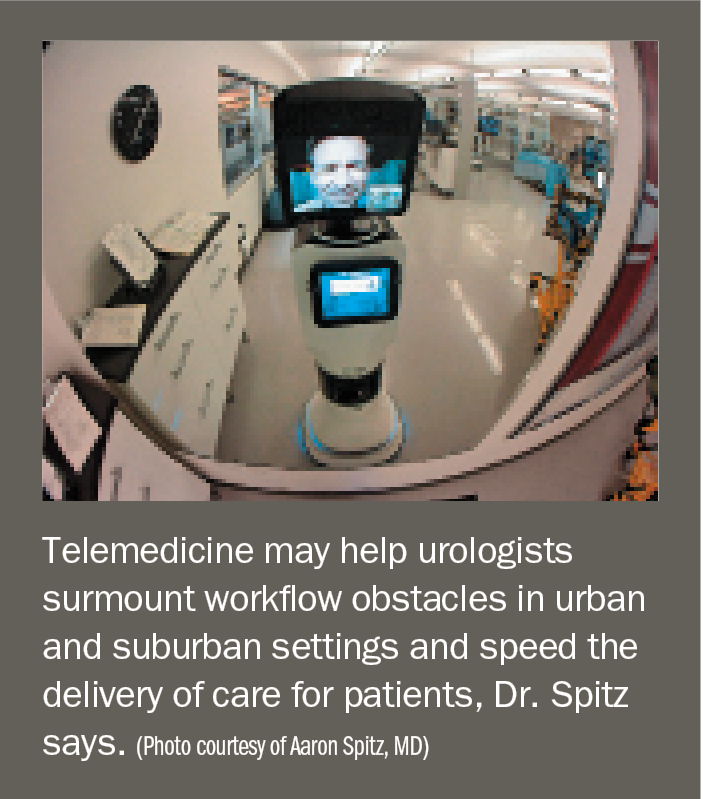Article
Telemedicine’s use may expand beyond rural settings
Urologist Aaron Spitz, MD, says there’s a need in urban and suburban America to streamline access to urologists in emergency medicine and urgent care, and telemedicine is one solution.

Dr. SpitzTelemedicine has applications beyond care delivery to rural and underserved areas. Urologist Aaron Spitz, MD, is spearheading an effort in California to bring tele-urology to hospitals in Orange County and beyond. He says there’s a need in urban and suburban America to streamline access to urologists in emergency medicine and urgent care, and telemedicine is one solution.
Dr. Spitz is a partner in Orange County Urology Associates, Laguna Hills, CA, and is assistant clinical professor of urology at the University of California, Irvine. He and colleagues in orthopedics have joined to launch telemedicine services at two local hospitals and an urgent care center. The hospitals already have the infrastructure, including RP-VITA robots (In Touch Health), which they use in neurology, pediatric surgery, and psychiatry.
Related: Tele-urology moves from concept to practice
Urology and orthopedic surgery will be the first specialties to provide telemedicine evaluation in these facilities’ emergency rooms and in the urgent care setting. Dr. Spitz plans to expand telemedicine services to other hospitals after this initial launch.
We asked Dr. Spitz, who presented on the topic at the Practice Management Conference during the AUA annual meeting in New Orleans, to share his insight with Urology Times.
NEXT: Overcoming workflow obstacles
More recent Urology Times articles
Getting started with telemedicine: A 4-step approach
What is your practice doing to enhance its income?
Is billing for stone prevention counseling possible?
Overcoming workflow obstacles
UT: How might telemedicine apply to urology practice in urban and suburban areas?
Dr. Spitz: There are workflow obstacles for surgical subspecialists and patients in urban and suburban settings.

Most hospitals do not have in-house urologists. When a patient presents to the emergency room, requiring a urologist consultation, the urologist would typically have to leave his office and travel to that ER to see the patient. In most cases, that will not occur until the urologist has completed his office work; so, it might be during his lunch or after the end of his workday. There are other potential obstacles to timely care of the patient, including traffic.
As a result, the patient and the emergency room doctor or admitting hospitalist will have to wait potentially several hours or all day to receive an evaluation and a disposition as to what the next treatment steps will be.
UT: How does telemedicine, potentially, solve the problem?
Dr. Spitz: I can actually receive all the same data-x-ray, CT scan, vital signs, blood and urine test results, input and output of fluids-that I would if I physically went to the hospital because all the data is now in the electronic medical record. The audiovisual platform allows me to physically see the patient and the patient can see me. With an assistant at the patient’s bedside, which may be the doctor, a nurse, a physician assistant, or nurse practitioner, although I can’t touch the patient with my own hands, I can observe the exam, the patient’s reaction to it, and the description of it. I can ask questions and speak to the patient and family.
Read: Statins delay PCa progression in patients on ADT
In many cases, all that will be sufficient for me to do the patient evaluation, as well as the disposition and obtain an informed consent for a procedure, if necessary. All of that can happen in the same amount of time it would take me if I were physically there, which typically is 15 minutes. And I can insert that 15-minute disruption into my office workflow, with a minor amount of delay.
If the patient requires surgery, it can be scheduled to occur as soon as I’m available, versus only starting the scheduling process after I’ve physically seen the patient. On the other hand, if the patient needs an intervention from another service after the consultation because I’ve determined that it’s not necessarily a urologic condition, the process of bringing in other services has not been unnecessarily delayed.
There’s one other scenario. It may be the case right after the doctor has evaluated the patient with all the tools-the robot, the EMR, etc.-that the urologist decides he physically needs to see that patient to complete the evaluation before making recommendations. At that stage, the patient will have to wait for the urologist to arrive; however, there is at least a doctor-patient relationship established. There will likely be some instructions the doctor can act on, such as if the patient has to be admitted or not. So, even if the full evaluation cannot be accomplished tele-medically, the part of the interaction that it did accomplish is still valuable.
NEXT: Telemedicine's application in urgent care
UT: What is telemedicine’s application in urgent care?
Dr. Spitz: Currently, patients who are evaluated and treated in an urgent care setting are not able to be evaluated and treated for urologic conditions. Patients typically are instructed that they have to follow up with their primary care doctor to receive a referral to a urologist. Occasionally, they’re told to go directly to a urologist, but it will have to be a referred urologist because there is no in-house urologist available in the urgent care facility.
With telemedicine, if the patient has a urologic condition that is amenable to telemedicine evaluation, that patient can receive the evaluation from a urologic physician, without having to go through one or two more steps.
An example in urgent care setting
UT:Can you give readers an example or two of what might occur in the urgent care setting?
Dr. Spitz: A patient may present to an urgent care clinic with a kidney stone. The urgent care clinic that I’m going to be working with has CT scan, x-ray, and ultrasound, as well as blood and urine diagnostic testing.
If the patient presents with symptoms of kidney stone, a CT scan can be obtained that confirms the diagnosis. Blood and urine tests can be obtained that notify me if the patient has signs of kidney impairment or infection.
Let’s say the patient has a kidney stone that is not infected and is not impairing his kidney function; the stone is of a certain size and location that will not pass spontaneously; and his pain can be controlled with oral pain medication. That patient can be informed with confidence of his condition. We can start treating his pain, and we can get underway with setting up a time for a kidney stone treatment. The patient can follow up with me, in-person, subsequently. But the scheduling of the procedure will all be underway.
Without telemedicine, the patient might be told that he has a kidney stone and he needs to see a urologist. The wait time to see the urologist might be 3 to 6 weeks. Once the urologist sees him for the first time, initiating the scheduling process might result in a further delay.
The whole workflow and care of that patient is radically expedited because of telemedicine availability in urology.
Recommended
Popular hospital rankings don’t correlate with outcomes
Test significantly impacts prostate Ca Tx recommendations
Selective clamping promising in robot-assisted PN
Subscribe to Urology Times to get monthly news from the leading news source for urologists.




